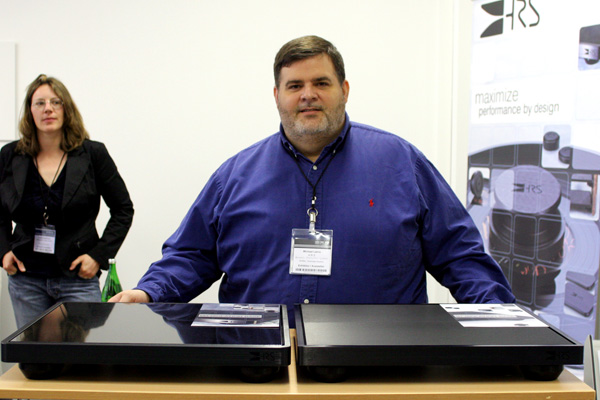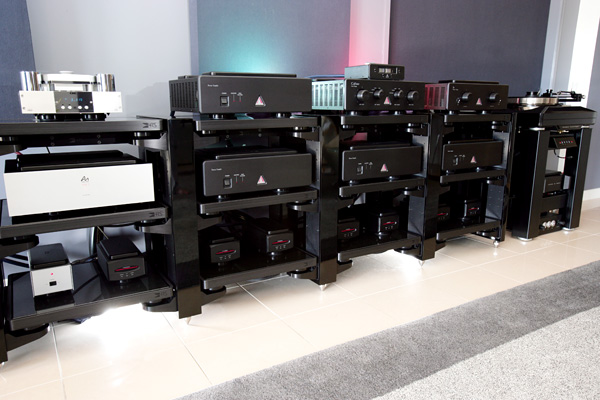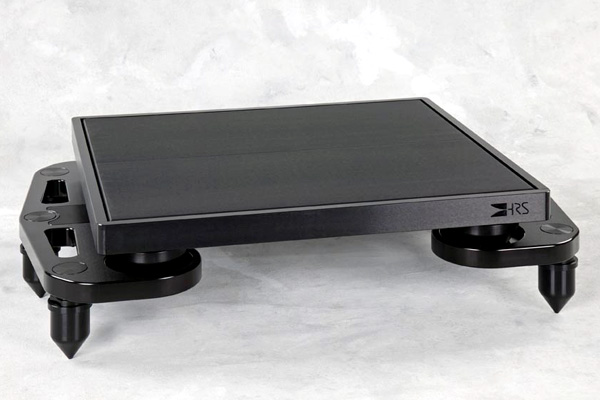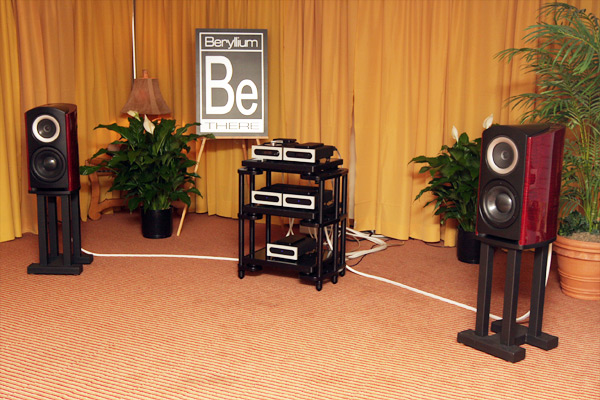 |
||||
| November 1, 2008 Searching for the Extreme: Michael Latvis of Harmonic Resolution Systems Michael Latvis of Harmonic Resolution Systems, based in Buffalo, New York, has an impressive technical background. He earned degrees in engineering and design from New Hampshire Technical Institute and Rochester Institute of Technology. He’s worked with nuclear power systems; helicopter rotor-bearing, engine, and transmission vibration-isolation systems; and vibration-isolation and interior noise-reduction systems for commercial aviation, army and navy weapons systems, and industrial computers and electronic components. He holds three US patents (a fourth is pending), as well as a number of international patents related to shock, vibration isolation, and audio products. And he’s a life-long audiophile. I asked Latvis about the history of his company. "I founded Harmonic Resolution Systems [HRS] in 2000 to focus on the development of products specifically for high-end audio and video equipment. All HRS products are proprietary designs that utilize concepts derived from decades of engineering and audio system experience. This knowledge and technology is combined with engineering measurements and listening tests to validate design and musical performance. HRS also develops its own proprietary materials that are used in these products to maximize performance."
There are audio racks that are designed more as fine furniture, and then there are audio racks designed as high-performance components themselves. HRS products fall into the latter category. But what is it, exactly, that separates the two? I asked Latvis to tell me what his racks and stands do when components are placed on them. "The main goal of all of our products is to eliminate the loss of information caused by reading errors and the information loss caused by noise being introduced back into the signal path during amplification and transmission of the signal from the source to the speakers. By maximizing the retrieval of information and preserving the transmission of the signal, you end up with a much more realistic and believable musical presentation that has the ability to trick the human senses into believing that you are listening to and experiencing an actual musical event and not a reproduction of that event. This illusion of reality and the increased ability to stir human emotion is, in my opinion, the essence of true high-end audio. Audiophiles have two sources of vibration to contend with. The first are vibrations that originate from outside the components themselves. I wanted to know how Latvis isolates components from these. "We achieve the lower noise floor at each shelf by using a high-mass plinth that is decoupled from the support structure with a relatively soft primary isolation stage that prevents the transmission of noise from the support structure to the component. The primary isolation stage is specifically designed for a range of component weights. This allows us to obtain optimal performance for a specific component vs. a one-size-fits-all mentality, which, in our opinion, does not allow you to achieve maximum performance. Another unique feature with our design is that the load range can be easily changed by customers if they make a significant change in the system. The load range of any of our isolation-base designs can be changed as many times as needed by the customer for about 10% of the purchase price. This allows customers to keep the system at maximum performance and preserve their initial investment should they make significant changes in component weight. "Each Isolation Base is designed to be used on any surface. They can be used on the floor, in an existing frame system, or in one of HRS’s reference-level frame systems. This allows our customers to build their system one Isolation Base at a time, then purchase the frame system at a later date. When using one of our frame systems, we also have control over the frame mass, stiffness, damping, primary frame modes, and surface-contact conditions. This additional design control allows us to further optimize the system performance and increase the level of noise reduction achieved at each component."
The next question was obvious: What methods does Latvis use to dissipate vibration created by the component itself? "The primary noise path for most components is from the supporting structure to the component and from the air to the component. In the latter case, you want to minimize chassis-noise amplification and dissipate the vibration from the chassis. HRS designed the Nimbus and Damping Plate product lines specifically for chassis-noise reduction. These products add stiffness, mass, and damping (both frictional damping and constrained-layer damping) to the chassis in a manner and quantity controlled by the listener. The HRS Nimbus products were specifically designed, using our proprietary HRS polymer, for bottom-panel resonance control and energy dissipation. The HRS Damping Plates were specifically designed, again using our proprietary HRS polymer, for top-panel chassis-resonance control and energy dissipation. The more products you add to the system, the more control you get and the greater the dissipation capacity. In some cases, the component itself may generate internal vibrations, from transports, transformers, etc. The Nimbus and Damping Plate products will dissipate any internally generated noise in the same manner." Design elements based on solid engineering efforts seem the order of the day at HRS. But we all know there are plenty of snake-oil products in high-end audio, and that some things whose operation sounds logical just don’t work. My next question: What are some of the myths associated with component isolation? "I think one of the myths we still run into from some people is that record players are sensitive to vibration but digital and other electrical circuits are not. There seems to be a more general acceptance that turntable performance can be improved by reducing mechanical noise that reaches the stylus. It is obvious that the turntable cartridge is an accelerometer reading the frequency and amplitude of the grooves in the album. The cartridge converts the mechanical motion to an electrical signal, which is then amplified to drive the speakers. Because the cartridge is converting mechanical motion to an electrical signal, most people can see clearly that erroneous mechanical noise that also reaches the stylus will be converted to electrical noise and that this noise will damage signal quality. "What is less well known to audiophiles is that there are many other devices that convert mechanical noise to an electrical signal (noise). In many industries, these devices are commonly used to measure stress in parts, the dynamic response of mechanical systems, and the frequency and amplitude of vibrating systems. A host of other measuring devices are used in many processes and product applications. All of these devices convert a mechanical event to an electrical signal in order to easily process and use the information. "One of the most common devices used by engineers to measure mechanical motion is a strain gauge. A strain gauge is very simple and consists of a relatively thin wire bonded to a film. The film is then bonded to a mechanical part. A charge amplifier is used to put an electrical signal through the wire. When the part under test moves, the thin wire changes form and the result is a change in resistance. The change in resistance is measured as a change in voltage through the device. The mechanical motion is now read as an electrical signal. This mechanical-to-electrical conversion through a simple wire is so reliable that engineers developing critical aircraft systems and many other products use it to measure stress, frequency, and vibration amplitude. Companies all over the world use strain gauges every day. "Another myth is that the level of audio improvement you can achieve by use of isolation products is more limited than other types of system improvements such as changing speakers, etc. While this may hold true for entry-level systems of modest performance and price points, our experience has been that one of the weakest parts of many high-performance systems is still in the area of mechanical isolation and noise reduction. Once you have a decent high-resolution audio system, vibration and mechanical noise causes a significant audible degradation of the signal. The fact that the vibration is the root cause of this degradation and is one of the primary limitations to their system performance is not always obvious to people as they swap out one high-quality component for another. The loss of information and added artifacts caused by vibration and noise can remove the essence of what makes a high-end audio system a special experience for the listener. The sonic improvements made with well-designed noise-reduction products are not only significant, but also unique in nature and cannot be achieved by other means."
Knowing how varied are the components available to the audiophile, my next question was about whether different audio components pose different challenges for HRS products. "In general, the challenge and solution are the same for a majority of components. When designing HRS products, we stay very close to good, fundamental engineering practice as well as confirming our designs with extensive listening tests. You just need to make sure you select the proper Isolation Base and load range. The exception to this rule is with very large turntables or amplifiers. If the component has a great deal of weight shifted away from the center of the component, like large transformers in the front or back of an amplifier, you need to make sure the HRS Isolation Base was properly selected for this component. HRS has an extensive engineering application file on components like this from all over the world. You just need to tell your local authorized HRS dealer the model of the amplifier, turntable, or component that has the off-center loading condition and we will identify the exact custom model for your unit. The nice thing about all our custom designs is that, like our standard designs, they can also be rebuilt for a fraction of the original purchase price to be a standard load range or a different custom configuration. We do build or can build an Isolation Base for every component in the world. There is no system we have not been able to do with our design approach."
Lastly, I wanted to know if some types of products are immune from vibration. "None that we have experienced or tested. The optimal product mix of Nimbus, Damping Plates, and Isolation Bases will vary based on the component design and what the customer feels is ideal, but we have not experienced a class or brand of component that did not benefit from the noise reduction achieved by HRS products. Some products will benefit more than others, based on how sensitive the circuits are to the noise that is present, but our testing has shown that it is always very easy to hear the improvements, and that all audio components respond to this improvement in a similar manner." Look for a review of a Harmonic Resolution Systems product in the near future. . . . Jeff Fritz
Ultra Audio is part of the SoundStage! Network. |



